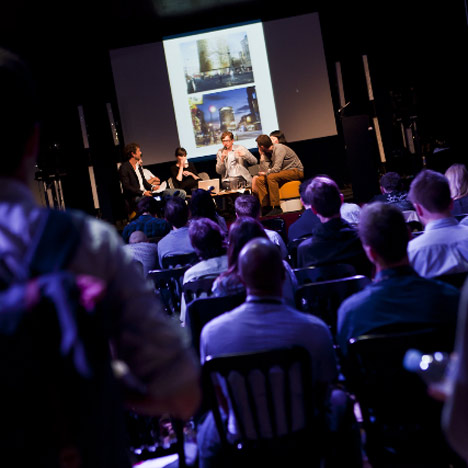
Designed in Hackney Day highlights
Dezeen Wire: “Software is the most important material we have come across in the last 100 years,” said Matt Jones of London studio BERG at yesterday's Designed in Hackney Day of talks and discussions with some of the most interesting designers and architects from Dezeen's local borough, curated in collaboration with Beatrice Galilee.
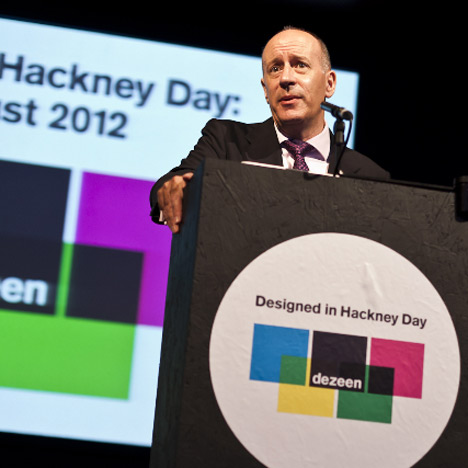
Mayor of Hackney Jules Pipe (above) opened the event, saying that while the cutting-edge creative companies Hackney is known for may not make an obvious impact on economic growth individually, "in aggregate, they are a huge business in Hackney, and it is those start-ups and incubator spaces that we are keen on creating."
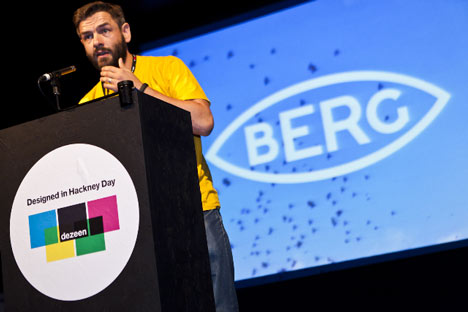
Digital Poets
“Software is the most important material we have come across in the last 100 years”
The talks kicked off with the theme of Digital Poets. Matt Jones (above) of BERG, Eva Rucki of Troika, Liam Young of Tomorrow's Thoughts Today and writer and designer James Bridle urged designers not to separate the physical and virtual worlds in their work.
Matt Jones from design consultancy BERG began by getting the audience talking with his mantra for 21st century design: “There is no separate digital world. We must treat software as material.” After showing us projects including a comic that reveals characters’ hidden thoughts under UV light and a smart printer that creates customised mini-newspapers, he concluded: “Software is the most important material we have come across in the last 100 years.”
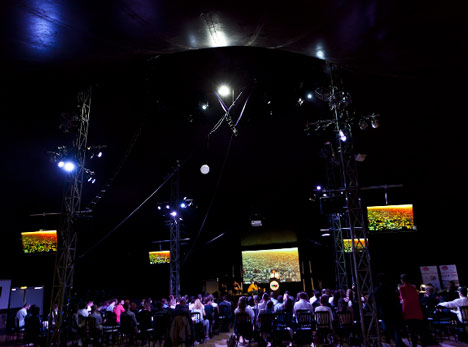
Next, Eva Rucki from design studio Troika explained how she uses technology to engage people. "We try to create immersive experiences that make people consider things differently," she said, citing the studio’s recent project in Hoxton Square, east London – The Weather Yesterday is a technologically-enabled LED installation that displays the weather from 24 hours ago and encourages participation and conversation in a public space.
James Bridle’s projects further his mission to make the internet “burst out onto the streets”, including animated GIFs on bus stop roofs and an imaginary airship that navigates using data from a London weather station. The audience especially liked Bridle’s assertion that pubs are vital to British design, proving a casual forum where designers can meet up to discuss big ideas.
Finally, Liam Young from Tomorrow’s Thoughts Today wowed us with an in-depth presentation about the intersections between nature and technology, arguing that “nature hasn’t been unspoilt for a long time”. He thinks cities have become “contemporary jungles” containing “a mash-up of nature and technology”, an idea that has inspired his own projects combining science fiction with science fact.
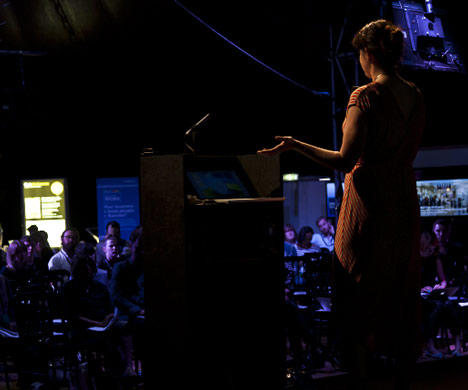
Imagine: the Science of Design
"You can do things yourself; you can become an expert"
Jane ni Dhulchaointigh's talk about making her fix-anything rubber moulding product Sugru a reality was the highlight of the Science of Design talks: she found everything she needed in Hackney to create the product she believed would empower people to change their surroundings and continued against financial odds to build her own brand. Her idea was that "when you modify or repair something it begins to mean more to you", so instead of buying new items she created the air-curing silicone rubber so users can "hack" their belongings to more exactly fit their own needs.
Dhulchaointigh's business is "a twenty-first century materials company with design and technology networks," featuring images and videos of the inventive uses customers find for Sugru, such as a drop-proof camera for a three year old. It's even being used to improve the grip of a Team GB Olympic fencer's foil. Sugru's message is one of empowerment: "you can do things yourself; you can become an expert."
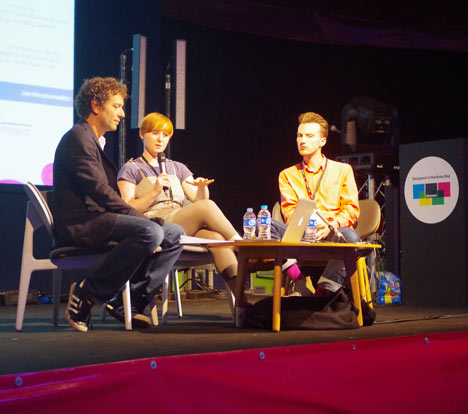
The Next Generation: Young Hackney Architects
"Architecture as software"
After lunch the discussion moved onto architecture, as architects from young Hackney-based practices We Made That, Erect Architecture, Studio Weave and Gort Scott joined Dezeen editor-in-chief Marcus Fairs on stage to explain how they’ve each reinvented the design process in their projects. The focus of each presentation was on architecture as a form of software rather than hardware; a tool for enabling the narrative of a building or space to develop.
Oliver Goodhall and Holly Lewis of We Made That (above) even made a newspaper rather than a building in response to one brief. The also showed the audience their recent Fantasticology project, for which they gathered nuggets of information and distributed them onto benches around the Olympic Park. The architects used open-source tactics to collect facts from the public and Lewis described how people had tracked down the facts they’d contributed. “We like to start conversations about high streets, neighbourhoods and the public realm,” explained Lewis.
Community engagement was a recurring theme, whether it involves making friends with the makers of projects like Je Ahn and Maria Smith of Studio Weave or getting the public involved in the design, like Susanne Tutsch of Erect Architecture. “We want to create learning opportunities for the people that take part as well as for ourselves,” said Tutsch. “This helps to create the sense of ownership that supports a project after the architect has gone”.
Gort Scott continued this theme and brought attention back to the role of small businesses, reminding us that "60% of all London's employment goes on around high streets" and they're crucial to creativity because that's "where collisions and conflicts between cultures happen."
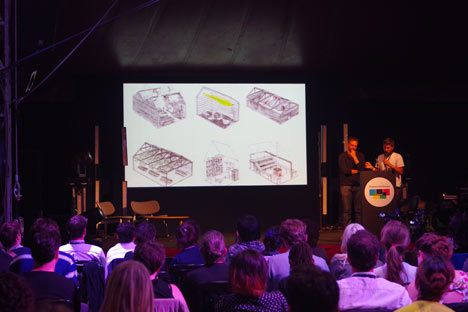
Pecha Kucha
The next session saw nine presentations in the fast-paced Pecha Kucha format, with designers showing 20 slides for 20 seconds each to give a flavour of their work.
Something & Son (above) stole the show, showing their attempts to bring nature back into the city, adding to the sustainability and self-sufficiency themes that cropped up throughout the day. Their FARM:shop project, which opened last year, transformed an empty shop in Dalston into a farm for growing fish, chickens and vegetables. They also showed Barking Bathhouse with its ‘cucumber ceiling’ and ‘sustainable steam room’, and a project in which they simply cut the roof off a car and filled it with plants.
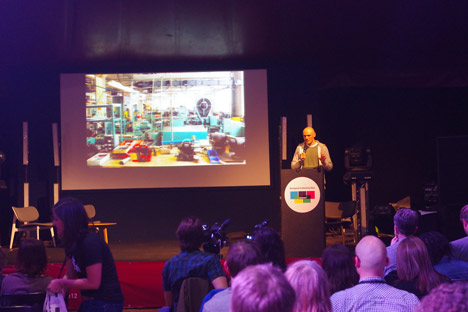
Shoemaker Tracey Neuls told us how a design-led approach found her moulding shoes with plasticine. “A childlike mindset helps to open your inspiration,” she said, explaining that her brand avoids trends, focusing instead on producing timeless design.
Designer Dominic Wilcox (above) presented one of his recent projects, a vinyl record called ‘Sounds of Making in East London’. Wilcox recorded 21 segments for his aural document, including bell-ringing, pie-making, beer-brewing and even the sound of packaging Sugru.
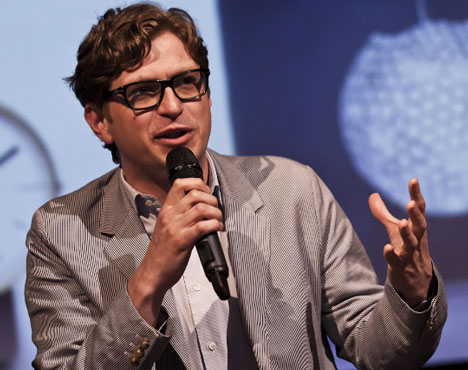
Reflections on Hackney
"It might be better to think of Hackney as a spirit or set of ideas"
The future of Hackney in the face of increasing gentrification was the focus of the closing panel discussion. Should artists and designers, who trade in new ideas, attempt to resist change?
Kieran Long (above), architecture critic at London’s Evening Standard newspaper, slammed the commercialisation of Shoreditch typified by a proposed hotel development on the former site of the Foundry, once a hub for young artists in the area.
“Once you’ve made a scene like this, people start to come and take advantage of it,” he said. “They use the brand of an artistic neighbourhood to build massive great hotels which, to my mind, have little or nothing to do with the architectural character of a conservation area – the Shoreditch triangle – and also have nothing to do with the social context of the artistic and design practice that goes on in Hackney and Shoreditch.”
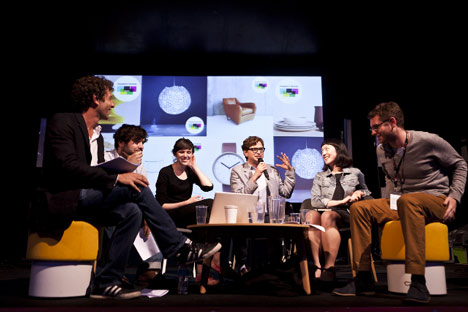
Sarah Ichioka from the Architecture Foundation drew attention to more positive developments up the road, with the Dalston Curve demonstrating a community space in the shadow of large-scale housing developments.
Oliver Basciano from Art Review pointed out that cheap rent and a strong peer network remain the most important factors for any creative, and Hackney’s increasing gentrification is nudging young artists towards cheaper areas like Peckham in south London.
An optimistic rebuttal of the fear of gentrification came from Rob Alderson, editor of art and design blog It’s Nice That: “Hackney has changed over the past few years, and the pace of that change is only going to accelerate after the Olympics,” said. “This edgy eastern Eden has now been completely co-opted by the mainstream.”
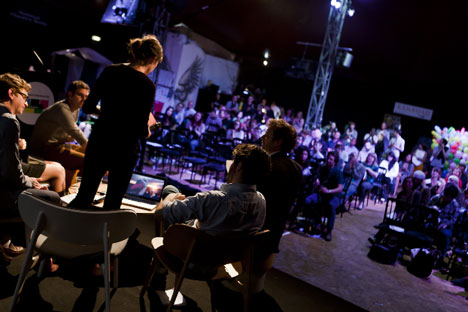
But Hackney doesn’t need to be guarded, he argued. It might be better to think of Hackney as a spirit or a set of ideas to be championed beyond the borough. “Creative movements are often rooted to a time and place,” he said, citing Madchester, Silicon Valley and the Bauhaus. “They’ve given the world ideas and principles that have outlived those times and outgrown those places.
“Rather than bemoan change or be scared of change, we can race it and hopefully do something really exciting.”
Designed in Hackney is a Dezeen initiative to showcase world-class architecture and design created in the borough, which is one of the five host boroughs for the London 2012 Olympic Games as well as being home to Dezeen’s offices.
Taking place at Hackney House in the heart of Shoreditch during the Olympics, Designed in Hackney Day celebrated the incredible diversity of design talent in Dezeen’s home borough as well as providing a platform to discuss both the opportunities and threats to creative businesses in this fast-changing part of London.
We’ve also been publishing buildings, interiors and objects that have been designed in Hackney all summer - see all our stories about design in Hackney here.
More information and details of how to get involved can be found at www.designedinhackney.com.
Photography is by Joel Knight.